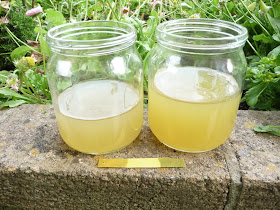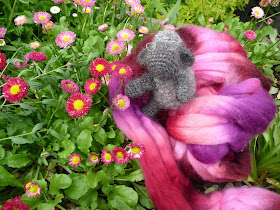 The Plant Dyes for All Seasons Calendar project for June is all about dyeing with weld plants sown in early spring. While I have previously had weld produce flower spikes in its first year, this year, my seedlings have only just grown big enough to be planted out. Picking enough leaves for a dye bath would likely kill the poor little things. The March page of the calendar says to sprinkle weld seeds on a seed tray and add a dusting of compost on top (which I'm sure is how I've done it before.) I wrap my seed trays in cling film and stand them on the underfloor heating in the bathroom. As soon as seedlings start to appear, the tray goes out to the greenhouse, which has a tiny heater that I only turn on if there is a frost forecast. This year, while other dye plants sprouted and went out successfully, the weld tray sat there like the girl neither captain chooses for their netball team, bare of growth in both March and after a second sowing in April. I began to think something was wrong with my saved seeds, til I read a bit more about weld and discovered it needs light to germinate. I shouldn't have sprinkled compost on top and I should have put the tray up on a window sill.
The Plant Dyes for All Seasons Calendar project for June is all about dyeing with weld plants sown in early spring. While I have previously had weld produce flower spikes in its first year, this year, my seedlings have only just grown big enough to be planted out. Picking enough leaves for a dye bath would likely kill the poor little things. The March page of the calendar says to sprinkle weld seeds on a seed tray and add a dusting of compost on top (which I'm sure is how I've done it before.) I wrap my seed trays in cling film and stand them on the underfloor heating in the bathroom. As soon as seedlings start to appear, the tray goes out to the greenhouse, which has a tiny heater that I only turn on if there is a frost forecast. This year, while other dye plants sprouted and went out successfully, the weld tray sat there like the girl neither captain chooses for their netball team, bare of growth in both March and after a second sowing in April. I began to think something was wrong with my saved seeds, til I read a bit more about weld and discovered it needs light to germinate. I shouldn't have sprinkled compost on top and I should have put the tray up on a window sill.In May, those barren trays left the bathroom for the greenhouse and over the next couple of weeks, weld seedlings finally appeared. In retrospect, I would have done better to advise sowing weld seeds in June or July, which is a much more reliable way of having flower spikes ready for harvesting the following summer. Biennial plants don't really suit a one year calendar cycle.
My apologies to anyone following the calendar who has had disappointing results. Hope your weld has done better than mine.
Why did I choose weld for June instead of an annual dye plant? Last autumn, while writing the calendar, I was particularly thrilled with the contact prints made by weld spikes dipped in iron water. This picture shows the detailed pattern left by the curving tips of weld spikes with hundreds of tiny florets and the yellow/green prints of the individual strap like leaves. The other kind of plant shown is coreopsis, which gives a more bronze dye print. If you have got weld plants with flowering spikes, to make the clearest prints, roll them in a heavier weight fabric. Cotton and linen should be scoured by washing in detergent, then mordanted by boiling for an hour in aluminium acetate.
Ordinary Alum only works for animal fibres. Aluminium acetate is not cheap, but you only need 5% of the weight of the fabric and you can buy it from Wild Colours website. After mordanting, give the fabric a rinse in plain water, stretch it out flat and lay on top the plants you plan to print with. I dip the weld leaves and spikes into a jam jar of water, vinegar and rusty nails, as the iron turns the prints from yellow to yellow/green, so they show up better. This fabric came from a cut up dress, I put the matching piece on top, rolled the sandwiched layers round a piece of plastic downpipe, bound the bundle with string and simmered it for several hours, left them it the pot overnight then waited a week for the fabric to dry completely before unrolling it to wash and iron.
I do at least have dried weld spikes, saved from last summer. When all this sowing and growing goes well, one plant will respond to having its flower spike cut off by putting out lots of lateral growth from lower down. The laterals all grow their own flower spikes a week or so later and then develop more laterals themselves, so even one good plant can be very productive in terms of space in the dye garden. In order to follow the calendar along as best I could, I crumbled up these four bunches into a large pot of water and left them to ferment for a week. Little bubbles appeared on the surface.Though the smell wasn't quite as evil as I remembered, it isn't pleasant.
I heated the pot for an hour while himself was out of the house and took it back outside before he got home. Once the weld had been sieved out, the dye bath looked its usual cloudy, whiffy and unimpressive self. The natural pH was about 5, bringing it up to pH 8 by adding a teaspoon of soda ash deepened the colour slightly - see jar on right.
In my experience, fresh weld is a really potent dye source, turning wool bright yellow with only a long, cold soak. Dried weld is definitely weaker, though I haven't quantified by how much. Adding alum mordanted wool yarn, I warmed this dye bath below the boil for less than an hour and left the wool in the the pot overnight. This photo shows 100g of millspun merino. For the Tour de Fleece this year, I will be spinning and dyeing a Speckled Face Beulah fleece. Couldn't wait til Saturday to make a start, so here are three small skeins I spun this week, all dyed with weld, the first alum mordanted only, the second modified by a brief simmer with iron after dyeing and the third modified with copper. The photo doesn't do them justice, I have them on the desk beside me and the true colours are more vivid, greener in shade.
 |
| Weld dye on wool, alum mordant for all, middle skein modified with iron, right skein with copper. |
Since both my trays of weld did germinate in the end, I have far more plants than I planned and should have absolutely masses of flower spikes next year. It comforts me to realise that so will anyone else who sowed weld this spring.































